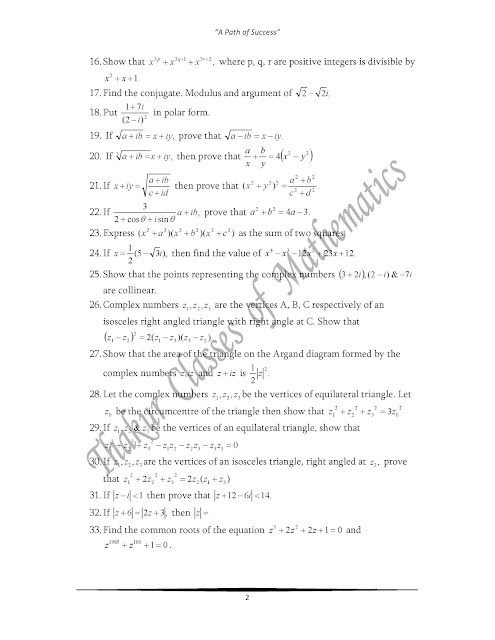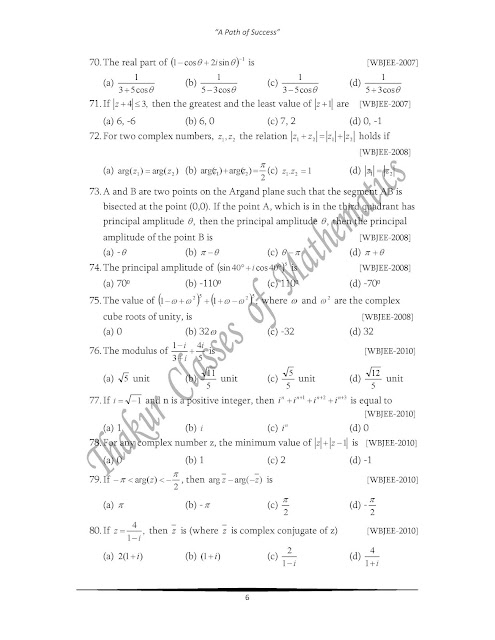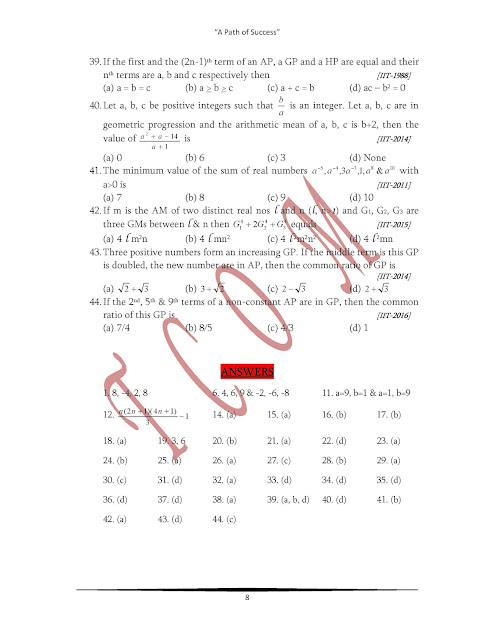Thursday, 30 April 2020
Wednesday, 29 April 2020
Sunday, 26 April 2020
Wednesday, 15 April 2020
Monday, 13 April 2020
Sunday, 12 April 2020
Saturday, 11 April 2020
Concept of Set Theory For Class-XI
SET THEORY
Set:-A set is a well-defined distinct collection of objects.
It is denoted by capital letters A,B,C,D,...... etc.
Representations:- There are two methods
of representing a set
1.Roaster or Tabular form:-In this form we list the elements within a curly bracket and separated by commas.
eg:-A = {3, 4, 5, 6, ... , 100}
2. Set builder form:-
eg:-A = {y : y = x + 2, x ∈ N}
Types of Set
1.Empty /Null/Void set :- A set which does not
contain any element is called the empty
set or the void set
or null set.
It is denoted by { } or ⱷ (phai).
2. Finite and infinite sets:- A set which consists of a finite number of elements is
called a finite set
otherwise, the set is called an infinite set.
3. Singleton set :- A set having only one element is called Singleton set.
4. Pair set :-A set having exactly two element is called
5. Equal sets:- Two sets A and B are said to be equal(A=B), if every elements of A is also an element of B and if every element of B is also an element of A.
6.Equivalent set :- . Two sets A and B are said to be equivalent if n(A)=n(B).
Subsets:- A set A is said to be
a subset of set B if every element of A is also an
element of B.
In
symbols we write A ⊂ B if a ∈ A ⇒ a ∈ B.
Superset:- If A ⊂ B then B is called superset of A.
Note:-Notation
1. set of real
numbers is denoted by R
2.set of natural
numbers is denoted by N
3.set of integers is denoted by Z
4.set of rational
numbers is denoted by Q
5.set of irrational
numbers is denoted by T
We observe that
N ⊂ Z ⊂ Q ⊂ R and T ⊂ R, Q ⊄ T, N ⊄ T
Intervals as subsets of R Let a, b ∈ R and a < b.
Then
(a) An open interval
denoted by (a, b) is the set of real numbers {x : a <
x < b}
(b) A closed interval denoted by [a, b] is the set
of real numbers {x : a ≤ x ≤ b)
(c) A closed open interval denoted by [a, b) is the set of real numbers {x : a ≤ x < b}
(d) An open closed interval denoted by (a, b] is the set of real numbers{x : a < x ≤ b}
Power set:- The collection of all
subsets of a set A is called the power set of A.
It is denoted by
P(A).
Note:-If the number of elements in A = n , i.e., n(A) = n,
then the
number of elements in
P(A) = nth power of 2
Universal set :- The superset of all given sets is called Universal Set.
It is denoted by U.
Operations on sets
1.Union of Sets : The union of any two given
sets A and B is the set which consists
of all those elements
which are either in A or in B.
It is denoted by A ∪ B
In symbols, we write A ∪ B = {x | x ∈A or x ∈B}
Venn Diagram
Some properties
(i) A ∪ B = B ∪ A
(ii) (A ∪ B) ∪ C = A ∪ (B ∪ C)
(iii) A ∪ ⱷ = A
(iv) A ∪ A = A
(v) U ∪ A = U
2.Intersection of sets: The intersection of
two sets A and B is the set which
consists of all those
elements which belong to both A and B.
It is denoted by A ∩ B
In symbols A ∩ B = {x : x ∈ A and x ∈ B}.
Venn diagram
Some properties
(i) A ∩ B = B ∩ A
(ii) (A ∩ B) ∩ C = A ∩ (B ∩ C)
(iii) ⱷ∩ A = ⱷ
(iv) U ∩ A = A
(v) A ∩ A = A
(vi) A ∩ (B ∪ C) = (A ∩ B) ∪ (A ∩ C)
(vii) A ∪ (B ∩ C) = (A ∪ B) ∩ (A ∪ C)
3.Disjoint Sets:- When A ∩ B =ⱷ, then A and B are called disjoint sets.
Venn Diagram
It is denoted by A – B
In symbols A – B = {x : x
∈ A and x ∉ B}
Also, B – A = { x :
x ∈ B and x ∉A}
Venn Diagram
5.Complement of a set:- Let U be the
universal set and A a subset of U. Then the
complement of A is
the set of all elements of U which are not the elements of A.
It is denoted by A′
In symbols, A′ = {x : x ∈ U and x ∉ A}.
Also A′ = U – A
Venn Diagram
Some properties
(i) Law of
complements:
(a) A ∪ A′ = U (b) A ∩ A′ = ⱷ
(ii) De Morgan’s law
(a) (A ∪ B)′ = A′ ∩ B′
(b) (A ∩ B)′ = A′ ∪ B′
(iii) (A′ )′ = A
(iv) U′ = ⱷ and ⱷ′ = U
5.Symmetric Difference of two sets:-The symmetric difference of two sets A and B is denoted by AΔB, is defined as
AΔB=(A-B)U(B-A)
Formulae to solve practical problems on union and
intersection of two sets
Let A, B and C be any
finite sets. Then
(a) n (A ∪ B) = n (A) + n (B) – n (A ∩ B)
(b) If (A ∩ B) =ⱷ, then n (A ∪ B) = n (A) + n
(B)
(c) n (A ∪ B ∪ C) = n (A) + n (B) + n (C) – n (A ∩ B) – n (A ∩ C) – n (B ∩ C) + n (A ∩ B ∩ C)
Subscribe to:
Comments (Atom)











































